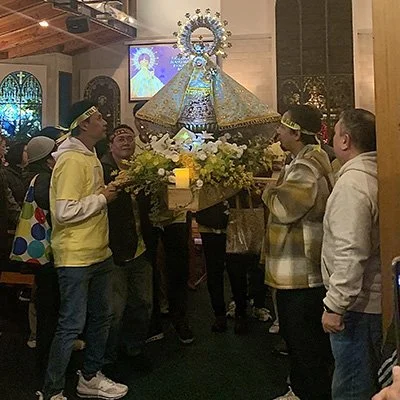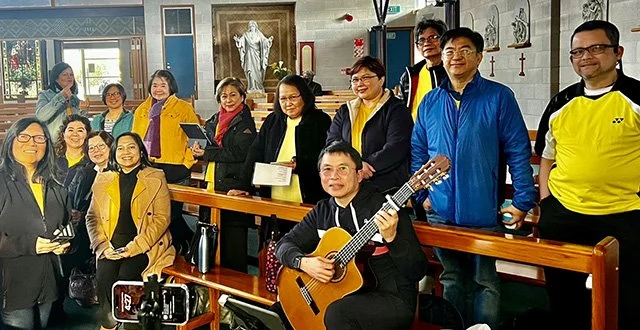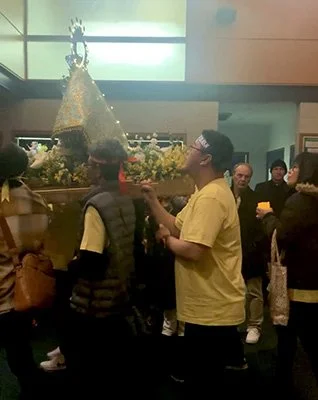Viva La Virgen! From Across the Miles
/Devotees carrying the image of Our Lady of Peñafrancia, Sacred Heart Catholic Church, Petone, Wellington, New Zealand (Photo by Ronald Salazar)
It is a unique experience to see and hear people pray, sing, reflect, and celebrate this feast–a tradition that dates back centuries in the Philippines, with its roots in Spain–in a foreign land. During the masses throughout the preceding week, songs in English, Spanish, Filipino, and Bicolano such as An Bilog Ming Buhay and Ina; Marian songs like Resuene Vibrante, Hail Mary, Gentle Woman, Awit ng Pagsuyo and even Maori songs such as Ka Waiata Ki a Maria’ all add solemnity and both a universal and a local feel to the occasion.
Bicol songs sung at Mass such as ‘An Bilog Ming Buhay’ and ‘Ina’, along with English, Spanish and Tagalog Marian Songs give both a local and universal feel to the occasion (Photo by Ronald Salazar).
This celebration in New Zealand was not always this big. In fact, it started with a handful of Bicolano families getting together to plan a yearly gathering to honor our Lady in September. Over the years, attendance has grown in what is now a fixture in the Wellington Filipino Community’s calendar, with novena masses every evening starting a week or so before the fiesta celebration on the Saturday.
The devotion to Our Lady of Peñafrancia goes way back to 15th-century Spain. The primitive image of the Virgin of Peña de Francia was found by Simon Vela on the slopes of Sierra de Francia, a mountain of rock situated between two famous provinces: Salamanca and Caceres. In the Philippines, it goes back to the 18th century in Naga City, in the Bicol Region. Around 1710, Rev. Fr. Miguel Robles de Covarrubias, upon the petition of the Cimarrones, built a chapel and, from a stampita (small image) he always had with him, had a carved wooden replica of the Lady of Peña de Francia enshrined in it. Immediately, people came to visit, most especially, during the Saturday novena and mass at the chapel. After a while, Fr. Miguel returned to Manila. But when he became totally blind in the left eye, he pledged to the Lady that he would return to Nueva Caceres and build the stone church he promised her.
In September of 2023, newly arrived Philippine Ambassador to New Zealand, H. E. Kira Christianne D. Azucena speaking at the fiesta celebration, highlighting the importance of these events (Photo by Ronald Salazar).
The present shrine was built by Bishop Ysidro Arevalo in 1741 and renovated by Francisco Gainza during the late 19th century to accommodate the growing number of devotees. As the devotion grew even more, a larger church was built on the other side of the river to house the image. It is an interesting coincidence that while the primitive image was found near Caceres, in Spain, its replica has come to stay in Nueva Caceres (Naga City) in the Philippines. This year, 2024, is the 100th anniversary of the Canonical Coronation of Our Lady of Peñafrancia as Queen and Patroness of Bicol.
In Wellington, New Zealand, the feast of our Lady of Peñafrancia has also become a symbol of the strong faith and unity not just of Bicolanos but of all Filipinos. Increasing Filipino immigration to New Zealand has contributed to the popularity of the event. Preparations start as early as May, with the assignment of choirs, logistics for the week of festivities, and the needed fundraising for the event.
Preparations start as early as May, with the assignment of choirs, logistics and fundraising needed for the event. Spring of Life Fellowship (SLF) choir practice before the mass (Photo by Ronald Salazar).
This also includes a roster for the Pagsungko, a pre-fiesta tradition in which the image of Our Lady is carried by devotees on their shoulders and brought to a certain community for an overnight vigil. It is a modified version: in this case, the image is welcomed by individual families into their homes for a week. Suffice it to say that Filipinos are only too happy to host, with prayer and devotion foremost in their minds.
The image of Our Lady of Peñafrancia being carried out of the church. The procession starts right after the Eucharistic celebration (Photo by Ronald Salazar)
As Wellington has many groups of different interests, diverse sponsors are tapped for each evening’s mass and the get-together that follows. Filipino clergy, New Zealanders, and priests of other nationalities, led by the Papal Nuncio or his representatives, officiate the evening novena masses, a mark of the wide network and impact the event has now.
Filipino clergy and New Zealanders along with priests of other nationalities officiate at the masses. Fr. Rico Angelo dela Torre bowed in prayer while the images of Our Lady of Peñafrancia and Divino Rostro are being blessed by H. Em. Cardinal John Dew, September 2022 (Photo by Ronald Salazar).
Right after the feast-day mass itself, a short procession of devotees carries the image of Our Lady from the church to a school hall, where the fiesta program takes place. Though not a fluvial procession like the one held in Naga City, the atmosphere is just as lively and reverent, with walkers reciting prayers. The hall for the gathering is spruced up to create a fiesta atmosphere.
I have vivid childhood memories of trips with my family to Naga City from Legazpi City. The day before and on the feast day of Peñafrancia itself, after hearing mass and watching the fluvial procession, we would move from house to house, greeting relatives and friends and partaking of the delicious food prepared for us. That same fiesta feeling comes back when we enter the school hall and are greeted with an array of familiar Filipino and Bicolano dishes laid out before us.
Like all fiestas, an evening program of songs and dances is an opportunity for our young people to participate and showcase their talents. There are speeches from distinguished guests as well. In 2023 the newly arrived Philippine Ambassador to New Zealand, Her Excellency Kira Christianne D. Azucena, highlighted the importance of these gatherings.
This celebration in New Zealand was not always this big. In fact, it started with a handful of Bicolano families getting together to plan a yearly gathering to honor our Lady in September.
The same group of families that started the whole idea of a fiesta also had the welfare of our countrymen at home in mind, starting a scholarship program for deserving students in Naga City. This sharing of resources through fundraising activities to benefit the less fortunate in the Philippines has been going on for several years now. More than ever, it embodies the ethos of Christian charity that we Filipinos take with us wherever we go. Filipinos around the world love good fiestas steeped in tradition. But amid the celebrations, their individual devotions, the veneration of the Blessed Virgin and the Divino Rostro, they do not forget to share their blessings with those who are in need. Ina (Our Blessed Mother) would be pleased “That in all things God may be glorified.”
SLF choir members with the image of Our Lady of Peñafrancia and Divino Rostro (Photo by Ronald Salazar).
References:
Vitaliano R. Gorospe, 1994, “Peñafrancia Revisited” <https://www.jstor.org/stable/42633419>
The Roman Catholic Archdiocese of Caceres, 2021, “History of the Devotion to our Lady of Peñafrancia” <https://www.archdioceseofcaceres.org/peñafrancia-history>
Vitaliano R. Gorospe; with R. Javellana, 1995, “Virgin of Peñafrancia : Mother of Bicol”
Ronald ‘Ronnie’ Salazar is a long-time resident of Wellington, New Zealand, a tech professional and a singer/songwriter who avidly follows Filipino community events. His compositions are on Spotify, Apple Music and on his YouTube channel. He is past president of Spring of Life Fellowship, whose choir sings regularly at the Feast of our Lady of Peñafrancia and at parish masses in and around Wellington.
More from Ronald Salazar










